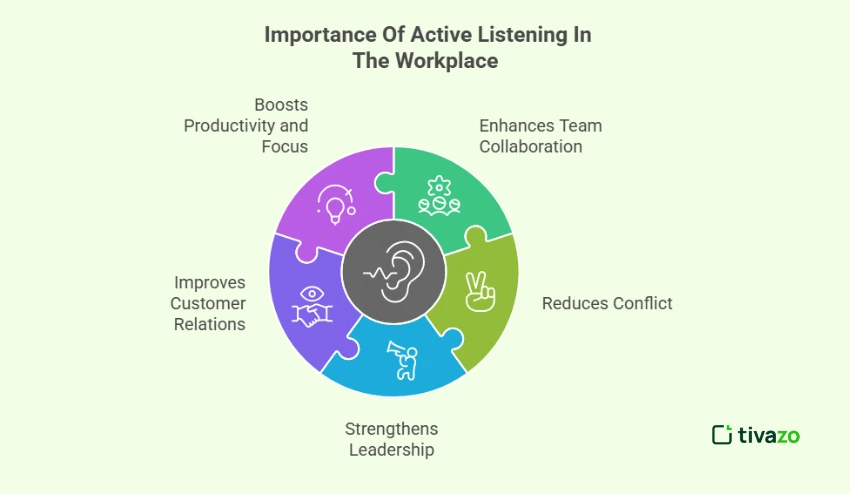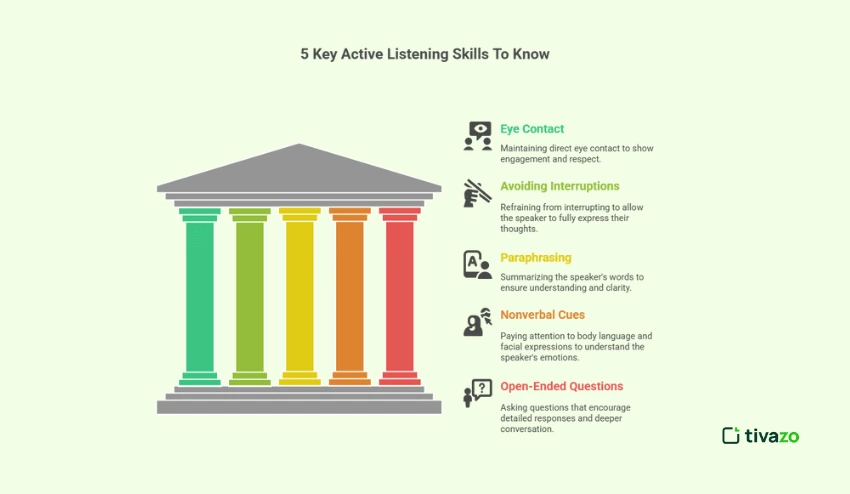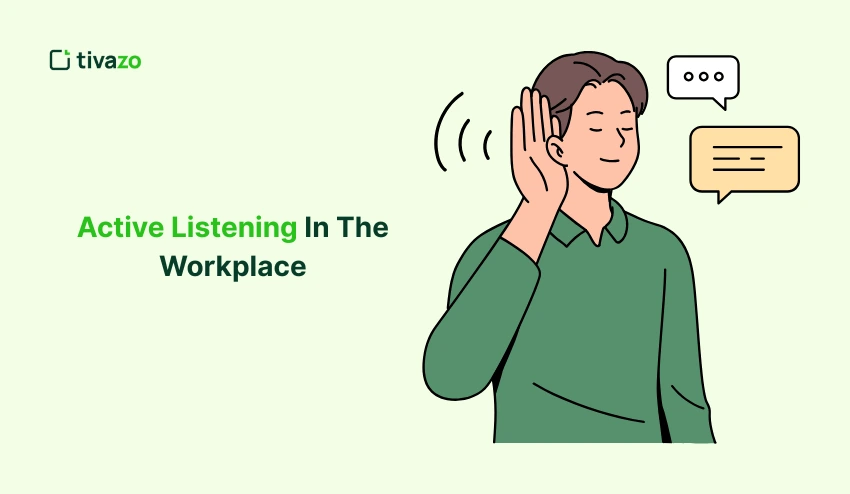Have you ever observed how much easier it is when individuals really listen to one another? It is a shame that active listening in the workplace is not given much attention, as many misunderstandings and opportunities are lost because of it.
Active listening is one of the most important skills that should be learned in the current dynamic work climate to enhance communication, improve teamwork, and increase employee engagement. This blog will consider the meaning of active listening, its relevance, the most important skills that you require, and practical examples to enable you to be a better listener at work.
Active listening in the workplace is more than just listening to the words- it is the ability to listen to what is being said and react to it with compassion and clarity. You can minimize conflict and increase productivity and trust by learning to develop the necessary skills, such as eye contact, open-ended questions, and nonverbal communication. We will also discuss the various forms of active listening and provide some tips on how you can promote active listening within your team. As per industry research, effective listening teams perform much better and are more innovative. Are you ready to change the communication in your workplace? So, time to get in.
Key Highlights:
- What is active listening in the workplace?
- Why Is Active Listening Important?
- Importance of Active Listening in the Workplace
- 5 Key Active Listening Skills
- Types of Active Listening in the Workplace
- Examples of Active Listening in the Workplace
- How to Encourage Active Listening in the Workplace
- Challenges of Active Listening and How to Overcome Them
What is Active Listening In The Workplace?
Active listening in the workplace is the art of paying full attention, comprehending, reacting, and remembering what a person is saying when conversing. It is an active process that requires full attention, verbal and nonverbal communications, and sensitive feedback as opposed to passive listening. This competency enhances effective communication, minimizes misunderstandings, and builds trust among team members. Through active listening in the workplace, employees and leaders will be able to establish a more collaborative, respectful, and productive workplace where everyone will feel heard and appreciated.
Why Is Active Listening Important?
Active listening in the workplace is crucial for successful communication, enhanced productivity, and the overall work culture. The active listening by the employees and leaders creates an environment where the flow of ideas is encouraged, feedback is taken seriously, and team members feel that they are actually heard. The result is a better morale, enhanced teamwork, and enhanced problem-solving.
The power to curb miscommunication is one of the greatest reasons why active listening in the workplace is imperative. Most of the conflicts in workplaces are a result of either bad listening skills or assumptions. When employees actually listen to what the rest are saying, in verbal and nonverbal ways, they can avoid miscommunication and solve problems before they become serious.
Also, active listening will enhance employee engagement, which is a major source of performance. Salesforce has produced a report stating that employees who feel heard are 4.6 times more likely to feel empowered to do their best work. It also boosts the relationship between managers and employees, enhances feedback culture, and makes staff work in teams by fostering openness and mutual respect.
In short:
- Builds trust and strengthens workplace communication
- Reduces conflict by eliminating communication barriers
- Increases employee engagement and job satisfaction
- Improves leadership communication and decision-making
- Encourages a strong feedback culture and active participation
- Enhances collaboration and drives workplace productivity
Importance of Active Listening in the Workplace
Active listening in the workplace is an essential skill that distinguishes high-performing teams. It preconditions good communication, enhances productivity, and establishes a positive and supportive atmosphere in which all people feel appreciated.
The following are some of the most significant reasons why active listening in the workplace is of great importance to organizations both large and small:

1. Enhances Team Collaboration
By applying active listening in the workplace, team members open up the venue for open communication and understanding. Workers who believe that they are being listened to would have a higher tendency to pitch in ideas, help in problem-solving, and remain loyal to the goals of the team.
A Gallup poll reports that engaged employees, who feel that they are listened to and respected, result in a 21 percent increase in productivity. This not only motivates the team to perform well but also enhances the general morale and confidence among the colleagues, which are the fundamental elements of effective employee engagement and team synergy.
2. Reduces Conflict
Most of the tensions in the workplace are a result of poor or a lack of communication. Active listening in the workplace becomes a culture that enables one to communicate effectively and makes others understand fully before responding.
Through the removal of assumptions and the promotion of well-thought-out answers, teams will be able to solve problems in a constructive manner rather than letting them grow. This assists in establishing a psychologically safe environment where concerns are listened to and acted upon as opposed to being dismissed, which is critical in a healthy feedback culture.
3. Strengthens Leadership
Good leaders are good listeners. When managers practice active listening in the workplace, they develop credibility, trust, and openness within their teams. When employees feel that they are being listened to by the leadership, they are more inclined to share their feedback or concerns or give ideas.
This two-way communication allows leaders to make better-informed decisions and respond to their team’s needs with empathy. It also improves manager-employee relationships, fostering transparency and emotional intelligence across the organization.
4. Improves Customer Relations
Active listening in the workplace does not end with internal communication, but also plays a great role in the way employees communicate with clients and customers. When the front-line staff are listening to what the customers are saying, they are able to provide a better solution to the problems and address them more effectively.
Such attentiveness results in increased customer satisfaction, loyalty, and brand trust. Companies that value listening during the interaction with clients will have a higher probability of establishing long-term relations and minimizing churn.
5. Boosts Workplace Productivity and Focus
The positive effects of active listening in the workplace have another important advantage, which is usually ignored, namely, its direct influence on both individual and team productivity. Meetings are more effective, instructions are more explicit, and fewer mistakes are made through miscommunication when people are able to listen.
Workers do not spend as much time sorting out duties or repeating work, so the work process is more fluent and the work is performed quickly. Such emphasis on proper communication is more productive in the workplace, and the teams would be able to adhere to deadlines more often.
To conclude, active listening in the workplace gives individuals and teams the strength to work together, address issues quickly, and be better leaders. It is not a soft skill anymore, but a strategic advantage that affects every aspect of your organizational success.
5 Key Active Listening Skills You Need To Know
In order to effectively take advantage of active listening in the workplace, there are a couple of communication skills that you must learn. These abilities will make you more in the moment, more aware of others, and help you play a significant role in discussions and group achievements.

1. Maintaining Eye Contact
Eye contact is one of the strongest nonverbal cues of interest and attention. When used in the context of active listening in the workplace, it demonstrates to the speaker that you are paying complete attention to them and that what they are saying is important to you.
It also enables you to be more focused, which limits the chances of distraction in places where multitasking is practiced. During face-to-face and online meetings, the ability to maintain constant eye contact promotes trust-building and enhances general communication in the workplace.
2. Avoiding Interruptions
Not interrupting people when they are writing a sentence is a little thing, but it goes a long way. Interruptions in the workplace can kill ideas, deter feedback, and cause tension among teams.
This is a good habit that should be applied during active listening in the workplace to improve a more respectful and inclusive communication process. It also facilitates a better manager-employee relationship since the team members are more secure and free to exchange ideas without the fear of being fired.
3. Paraphrasing for Clarity
Paraphrasing is the act of saying the words of another person in your own words to ensure that you understand. In order to illustrate, one can use the phrase, So what you are saying is…, which in turn clears up the message and allows both parties to be on the same level.
This competency will help with effective communication in the workplace, reduce misunderstandings, and foster a culture of purposeful communication. It is particularly practical at meetings, brainstorming, and feedback discussions.
4. Observing Nonverbal Cues
Communication consists of more than words. Facial expressions, postures, and tone of voice are some nonverbal signals that can tell the real feelings and intentions of the speaker.
When it comes to active listening in the workplace, by reading these cues, you will be able to respond in a more empathetic way and not miss out on emotional undercurrents. This will help to enhance teamwork and make you wiser at handling delicate or stressful cases.
5. Asking Open-Ended Questions
The nature of open-ended questions encourages more contemplative answers and conversations. Rather than posing the question, Did you complete the report? Ask, What were the difficulties during the preparation of the report?
This is an important skill when it comes to active listening in the workplace since it demonstrates that you are not merely hearing the responses, but you are also interested in the view of speaker. It fosters deeper discussions and helps to have a more open, innovative work culture.
These five skills will help you improve the quality of conversations and relationships in the workplace. By listening with purpose, you foster transparency, compassion, and improved cooperation throughout your organization.
Pro Tip: The Harvard Business Review reports that 85 percent of career success, whether in the workplace or outside it, is not about technical skills but rather about good communication and interpersonal skills. This is centered on active listening.
Types of Active Listening in the Workplace
The process of active listening in the workplace is not a one-size-fits-all type of process; instead, it changes according to the context, situation, and emotional tone of the discussion. Knowing the types will enable the professionals to adjust their communication style to be more helpful to colleagues, address problems, and improve productivity.
1. Reflective Listening
Reflective listening is aimed at listening to the feelings and purpose of the speaker and not only the words. This works well in the workplace, especially when conducting performance appraisals, resolving conflicts, or addressing issues concerning employee participation and well-being.
This kind of active listening in the workplace may include paraphrasing and validating feelings, like saying, It seems that you were angry when that happened. It enhances the development of trust and promotes open, sincere communication, which is essential to have good relations between the manager and the employees.
2. Comprehensive Listening
Comprehensive listening is concerned with processing the facts, ideas, and structure of the talk. This is necessary during team meetings, training, and strategic planning, where retention and clarity of information are important.
Active listening is a practice that should be applied in the workplace, and it will minimize the communication barrier, and vital instructions or information will not be misinterpreted. It also helps in improving productivity in the workplace as the teams remain aligned with the goals.
3. Empathetic Listening
Empathic listening is more concerned with emotional understanding and connection. It is particularly useful when other members of staff are under pressure, having problems, or going through personal difficulties that can affect their performance.
Empathetic active listening in the workplace is one of the tools that can be used to encourage psychological safety and create supportive mechanisms within the team. It is significant in the establishment of a feedback culture in which people are encouraged to express themselves without fear of being judged.
4. Critical Listening
Critical listening is the ability to assess the message thoroughly to find out whether it is accurate, relevant, or logical. The skill is very important when it comes to leadership positions, discussions in decision-making, or when there is a need to solve a problem.
Through critical active listening in the workplace, not only the leaders but also the team members can ask meaningful questions, question assumptions, and find superior solutions. It helps to make the communication process at the workplace more objective and data-driven, particularly in high-stakes environments.
Knowledge and use of various forms of active listening in the workplace enable professionals to vary their communication style depending on the situation at hand. Such adaptability will result in better relationships, wiser decisions, and an emotionally intelligent workforce.
Examples of Active Listening in the Workplace
It is good to know the theory, but it is better to see how active listening in the workplace works in real-life situations to be able to apply it. The following are practical examples of how listening actively can help to enhance the communication process, trust, and collaboration.
1. In Team Meetings
During a joint meeting, a project manager realizes that one of the team members is silent. Instead of proceeding to the next question, they encourage the individual to express his/her ideas and then restate the answer to ensure that it is understood. Such a small behavior of active listening in the workplace enhances inclusion, collaboration within teams, and valuing everyone.
2. During Performance Reviews
A manager who is carrying out a performance review allows the employee to air out his or her concerns without any interference. They paraphrase the key information of what they have listened to back to the employee, and then they provide feedback. Such application of active listening in the workplace assists in strengthening the relationship between the manager and the employees, improves the culture of feedback, and creates a mutual respect base.
3. Customer Service
A customer service situation would be the situation where the agent would not form any conclusions when the customer is explaining his/her problem. They repeat the problem and give a solution that is to the point. Active listening in the workplace is done, and it enhances customer satisfaction and makes employees develop good listening behaviors.

4. Data Point
It has been reported that 74 percent of employees believed that they were more effective when their managers listened to them as they talked about their concerns (Forbes). This demonstrates that active listening in the workplace has a direct relationship with enhanced employee engagement, enhanced productivity in the workplace, and enhanced job satisfaction at all levels of an organization.
These examples demonstrate that active listening in the workplace is not a theory but a practical and powerful tool for establishing better communication and relations. Listening skills are important whether you are a leader, a client manager, or you are in a meeting room; the skill of listening can change how you spend your day.
How to Encourage Active Listening in the Workplace
The process of establishing a culture of active listening in the workplace begins with leadership but has to be enforced at all levels. When companies focus on listening, they build better communication and engagement and a more collaborative work culture.
1. Train Employees on Listening Skills
The provision of training on active listening in the workplace has the benefit of making employees more self-conscious of their own communication patterns. Team members may be trained to acquire the required skills, such as paraphrasing, making open-ended questions, and understanding nonverbal cues through workshops or e-learning, which will improve team interaction and productivity.
2. Create Safe Spaces for Dialogue
Psychological safety is the most important factor to promote active listening in the workplace. Anonymous feedback mechanisms, open-door policies, and positive meeting cultures will help employees to feel that they can speak freely and that their words will be listened to and taken into consideration.
3. Recognize Good Listening Behavior
The importance of listening skills among employees should be reinforced by publicly acknowledging the employees who have displayed good listening skills. This can be during team meetings or even in performance reviews, and recognizing active listening in the workplace will encourage others to do the same, and will encourage a healthy feedback culture.
4. Use Technology Wisely
The digital tools such as Slack, Microsoft Teams, and Zoom are supposed to support, not to complicate, the real communication. Promoting considerate responses and minimizing multitasking in virtual interactions allows preserving the integrity of active listening in the workplace, even in remote or hybrid environments.
5. Regular Check-Ins
One-on-one meetings between managers and employees on a regular basis are a great tool to encourage active listening in the workplace. These frequent check-ins allow free communication, conflict resolution at early stages, and improved relations between a manager and an employee.
When there is a deliberate effort to ensure that there are systems in organizations to encourage active listening in the workplace, it becomes a habit rather than a skill. Companies can trust, enhance engagement, and increase the overall capability of the teams through modeling and reinforcement at all levels.
Challenges of Active Listening and How to Overcome Them
Despite its benefits, active listening has obstacles:
- Digital Distractions: Emails and notifications can derail focus. Solution: Set aside “no-distraction” zones or time blocks.
- Cultural Barriers: Differences in communication styles can lead to misunderstandings. Solution: Provide cross-cultural training.
- Time Constraints: Busy schedules make people rush conversations. Solution: Encourage quality over quantity in meetings.
Conclusion
It is no longer a possibility to listen actively at work; it is an essential skill that defines the quality of interaction, collaboration, and development of teams. With awareness of its value, drastic changes in productivity, morale, and overall success can be achieved through the practice of the 7 key skills and a culture of listening and paying attention.
And what are you going to do to begin to practice active listening in the workplace today?




